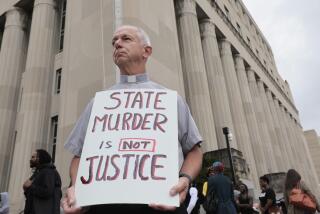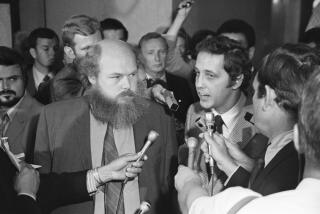Justices Get Case Where Death Row, DNA Collide
- Share via
WASHINGTON — The major death penalty case before the Supreme Court this year reads like a “whodunit,” as one judge put it. But if there is doubt about who did it, should the defendant be on death row?
The justices will hear the case Jan. 11. And though they might not solve the murder mystery, the case should give an early clue on whether the high court, now led by Chief Justice John G. Roberts Jr., is willing to overturn a death sentence if an inmate’s guilt is in doubt.
Paul G. House was the stranger in town in rural east Tennessee during the summer of 1985, when a young mother was abducted and murdered. House was a paroled rapist.
He had been seen walking on a road near where the woman’s body was found in Union County. And he lied to police, denying that he had left his girlfriend’s trailer the night of the murder.
Prosecutors told the jury that House had tricked his victim, Carolyn Muncey, into leaving her house at night with the intent of sexually assaulting her. A semen stain on her nightgown was linked to him, and a blood spot on his jeans matched her blood. House was convicted in 1986 and sentenced to death.
New evidence -- including DNA testing -- subsequently came to light that raised questions about House’s guilt. Yet a federal appeals court ruled that it wasn’t enough to reopen his case, despite his being on death row.
The justices will now decide whether to make it easier to reopen old cases when new evidence -- including DNA testing -- raises real doubts about the defendant’s guilt.
It has been a decade since the high court ruled on a case in which a death row inmate claimed that he was innocent. The justices described such claims as “extremely rare.” Since then, DNA testing has freed scores of convicted men by showing that hair, blood or semen found at crime scenes did not come from them.
In House’s case, DNA tests showed the semen sample on Muncey’s nightgown came from her husband, not from the man convicted of her murder. A state medical examiner also testified that a blood spot on House’s jeans was a result of contamination during testing.
Meanwhile, five new witnesses came forward to implicate the victim’s husband, Hubert Muncey Jr. Two women testified that shortly after the murder, they heard Muncey drunkenly confess to having killed his wife.
Nonetheless, the U.S. Court of Appeals for the 6th Circuit in Cincinnati, by an 8-7 vote, upheld House’s conviction, even though the majority agreed he had presented a “colorable claim of actual innocence.”
The eight judges in the majority said there remained strong circumstantial evidence of House’s guilt. He had lied to police, he was seen near the dead woman’s body and he had new cuts and bruises he could not explain. To win a reversal, a convict such as House “must do more than raise questions about the reliability” of key evidence against him, the majority said.
The outcome illustrated an old, if unstated, rule of law: While defendants are presumed innocent until proven guilty, convicts are presumed guilty until proven innocent.
Six of the dissenters were convinced that House was innocent and deserved to go free. The jury was told that rape was the motive for Muncey’s murder, noted Judge Gilbert Merritt, and that the semen evidence was crucial to the prosecution’s case. “The new evidence disproves the motive the jury accepted as the basis” for the crime, he said.
The seventh dissenter said House at least deserved a new trial.
All eight judges who voted to affirm the conviction were Republican appointees. The seven dissenters were Democratic appointees.
Stephen Kissinger, a federal public defender in Knoxville, Tenn., has worked on House’s case since 1997. He said he was convinced that no jury would convict his client, who is now in his mid-40s, if they had heard all the evidence. The new evidence surfaced after House had exhausted his appeals in Tennessee courts.
“The jury didn’t hear the overwhelming majority of the evidence in this case,” Kissinger said. “This crime is hard to understand without rape as the motive. Why would he leave his trailer and walk two miles at night to abduct Carolyn Muncey?”
Much of his brief to the high court is devoted to building a case against Hubert Muncey. Witnesses reported seeing him strike his wife. A local woman reported that on the day after the murder, Muncey asked her to state -- falsely -- that he had been at her house on the evening of the murder. A security guard disputed Muncey’s claim that he was at a dance at the time she was murdered. None of these witnesses testified during the trial.
However, a federal judge heard this evidence in a special hearing six years ago and refused to reverse House’s conviction.
Lawyers for the Innocence Project in New York say House’s case illustrates the problem posed by “false facts.” Juries are especially impressed with scientific evidence that, for example, links the suspect to the crime. This evidence is crucial in circumstantial murder cases, they say.
“DNA evidence has revealed a finite but troubling class of convictions tainted by what is best described as ‘false facts’: forensic evidence that likely carried great weight with the original jury, but which is now known, to a scientific certainty, to have been erroneous,” said Peter Neufeld, co-founder of the Innocence Project.
He urged the Supreme Court to rule that federal judges should reopen old cases when new scientific evidence showed that a jury relied on false facts.
But unlike the many instances in which DNA has freed a convicted prisoner, the new evidence in House’s case does not prove his innocence. Indeed, state prosecutors say they remain convinced they got the right man.
“There are cases where new evidence causes doubt, but this is not one of them,” said Paul Phillips, the prosecutor. He said House was convicted based on his own actions and by the testimony of his girlfriend. The semen stain was not crucial to the case, he said.
After denying he had left the trailer that night, House “told a wild story” about being abducted by two men. He returned home without his shirt and shoes. The next day, while neighbors were searching for the missing woman, two men encountered House near where her body was subsequently found. Phillips said he believed that House had returned to the scene of the crime hoping to recover his missing shirt.
When investigators found his muddy jeans in a laundry hamper, they saw a stain that was later determined to be blood from Carolyn Muncey. That evidence remains disputed, however, because a vial of the woman’s blood went missing after her autopsy, at a time when her blood and House’s jeans were being tested.
At first, investigators saw the woman’s husband as a suspect, but they turned their attention to House after the evidence pointed to him, the prosecutor said.
“I know with a pretty strong certainty that Paul Gregory House was the murderer,” Phillips said. “And if I have to try him again, I will do it.”
The Supreme Court has generally refused to reopen state cases based on new evidence.
“Claims of actual innocence based on newly discovered evidence” do not give federal judges grounds for reversing a state conviction, Chief Justice William H. Rehnquist wrote in 1993. “This rule is grounded in the principle that federal habeas courts sit to ensure that individuals are not imprisoned in violation of the Constitution, not to correct errors of fact.”
In recent years, the high court has overturned several death sentences, but usually because of a procedural violation, such as racial bias in selecting the jury or a defense lawyer’s failure to tell the jury of crucial evidence.
By contrast, House’s lawyers urge the court to rule for their client based on what they call a “persuasive showing of actual innocence.”
The Supreme Court will hear the case while a Senate committee is holding confirmation hearings for high court nominee Judge Samuel A. Alito Jr.
Alito, if confirmed by the full Senate, might hold the deciding vote. Often, when the court has been closely split on death penalty cases, retiring Justice Sandra Day O’Connor has cast the crucial vote. If the eight other justices are evenly split and Alito replaces her, he could cast the tie-breaking vote.
More to Read
Sign up for Essential California
The most important California stories and recommendations in your inbox every morning.
You may occasionally receive promotional content from the Los Angeles Times.














